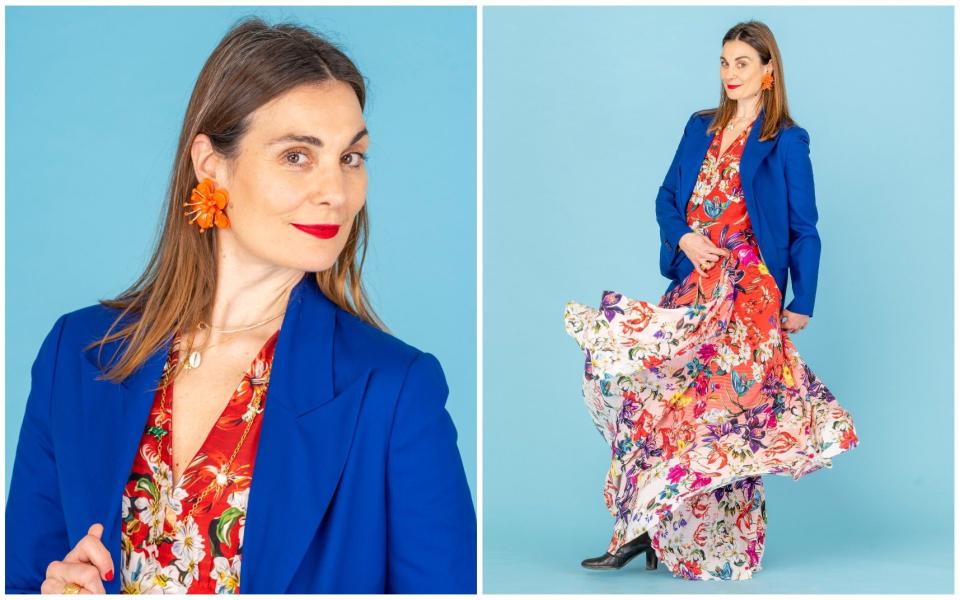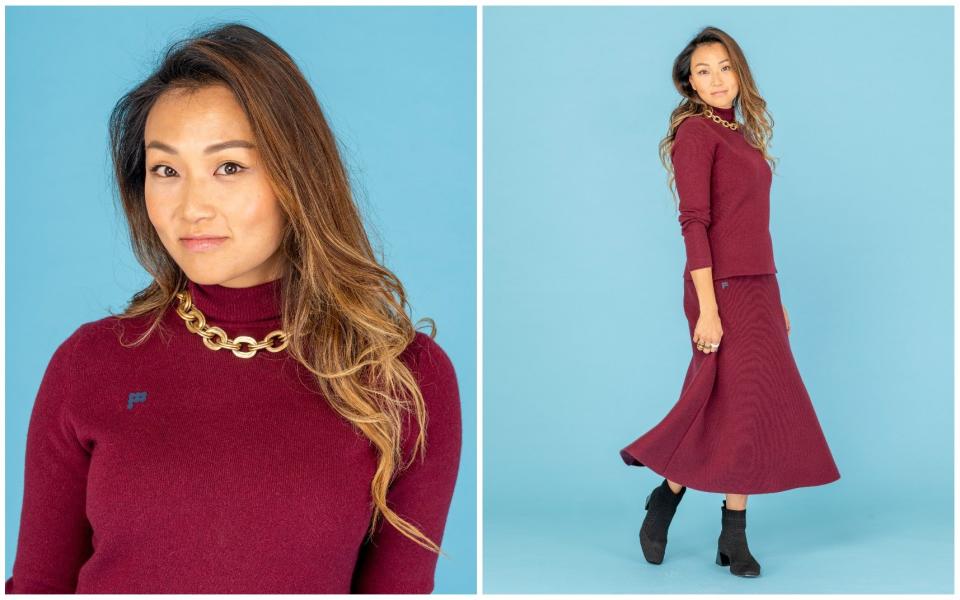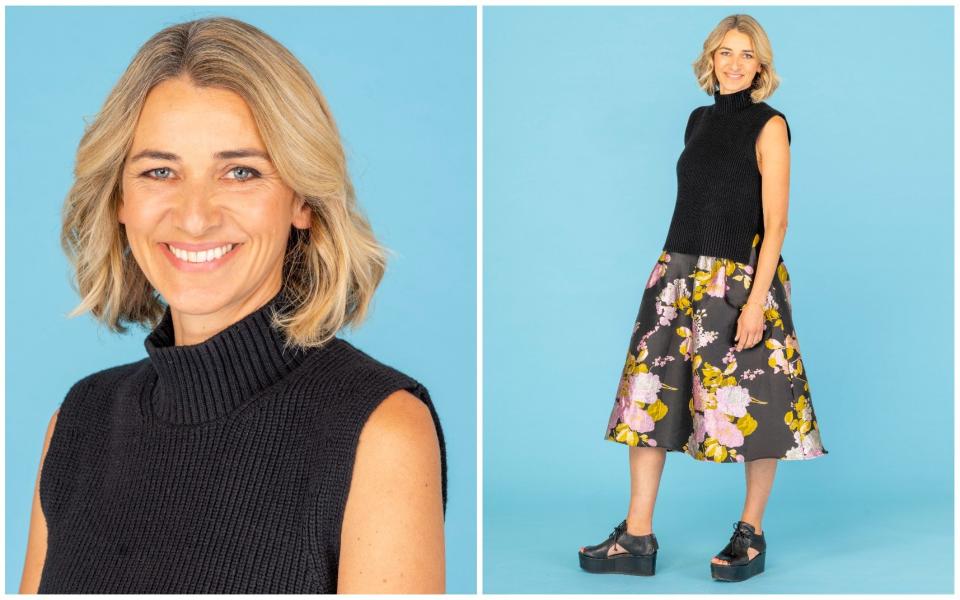How to buy less but still look stylish, according to the most influential women in fashion

When was the last time you bought a new piece of clothing? The January sales? A lunch-break browse in Zara? A late-night scroll on the Net-a-Porter app?
No matter how hard we try, most of us are buying more clothes than we should. Much more. A report from the Hot or Cool Institute says that the wealthiest consumers (those in the UK, US, Germany and Japan) should buy just five new (or preloved) items a year.
This, the think tank says, is the most effective way to ensure the fashion industry’s emissions are in line with the Paris Agreement’s goal – to keep the average global temperature rise below 1.5C. Fast fashion is a major culprit: as the cost of clothing has gone down, the volume purchased has gone up, and cheaper clothes means poorer quality. The result is that clothes have a shorter lifespan and more end up in landfill – even the stuff donated to charity. The report highlights that a “substantial share” of donated clothes exported as second-hand “end up directly in landfill or is incinerated”.
Some of the most influential women in fashion believe it is possible to break this hamster wheel of consumerism, and have pledged to buy no more than five new items (excluding hosiery and lingerie) this year. And they want you to do the same. This challenge does depend on your having a well-stocked wardrobe already.
“We have to change our behaviour,” says fashion writer and strategist Tiffanie Darke, who orchestrated the pact and enlisted the women taking part. “It’s going to be really hard. It’s like being on a diet,” she says. “After I’ve had my supper, I imagine all the chocolate that’s in the cupboard. I have to stop myself from eating the chocolate and it’s the same for the clothes. I’m interested to see if I can do it, but because I’ve come out so publicly, I have to stick to it.”
The good news is that there are lots of ways to bring your wardrobe to life that don’t involve buying new clothes, and these women know every tweak, trick and hack there is. After all, as Darke says, “the most sustainable wardrobe is the one you already have.”
Jane Shepherdson
Former Whistles CEO and chairman of My Wardrobe HQ

Symons blouse, £275, The Fold; Roksanda wide-leg trousers, to rent from £15 a day from My Wardrobe HQ; old Céline boots
With the My Wardrobe HQ warehouse at her disposal, Shepherdson doesn’t need to buy much these days: “I’m renting for occasions: weddings, big parties,” she says. “The thing I’ve rented the most is a Gucci suit. I would never buy it; it’s metallic, embroidered – and slightly out of my comfort zone – but it looks stunning.”
Instead of shopping, she’s in the habit of using a tailor to alter the fit of old wardrobe favourites. “I’ve got a few pairs of trousers where suddenly the leg width or the waist didn’t look right. There’s a jacket that I’m going to alter to a three-quarter length sleeve to make it look a bit fresher.”
One item which warranted an actual purchase is a blouse with pleated frills by The Fold. “It goes with everything,” she says. “It’s flattering, it’s navy so it doesn’t get dirty quickly, it’s seasonless; I can just throw it on and know that I’m going to look great.”
And the rest? “I haven’t got a strategy, but [former Céline creative director] Phoebe Philo is launching her new collection in September so I’m tempted to save it all up for that.” The flaw in that plan will be when something unexpectedly needs replacing. “Swimsuits are the sorts of things that are fine until a point, then suddenly you look at them and think I can’t possibly wear it. That’s going to be a real test.”
Maria Kastani
Fashion brand ambassador

Mary Katrantzou Go the Extra Mile dress, to rent from £30 a day from My Wardrobe; blazer £365, from Essentiel Antwerp; old Margiela boots from Joseph
Kastani is proof that forever fashion doesn’t have to be boring. Her first investment of the year is a pair of £65 Essentiel Antwerp earrings, which she hopes will deliver good cost-per-wear value: “They’re the colour of the happy chakra and as soon as they go on, my mood is elevated,” she says. “And I believe they go with anything: trainers, a long dress, joggers…”
Her next buy “will definitely be a dress”. They are the linchpins of her wardrobe, and she has no issue with wearing them again and again. She’s had sleeves added to some of her favourites to extend their life. “I have wonderful pieces from Alexander McQueen when he was still alive. I wear them all the time and I always have people asking where they’re from.”
She already shops with a sustainable mindset, and has some sound advice when it comes to so-called sustainable brands or textiles: “A lot of new brands try to invest into sustainable fabrics: however, some of these items are not going to last more than six months to a year.”
Quality, for her, is a non-negotiable. “I want to feel that what I have will last me, and [there is also] the romantic idea that I can pass things on to my daughter.”
And if she finds a piece that takes her over her quota of five? “If I see something that makes my heart stop, I will bite – but when I reset, I will give myself four pieces rather than five.”
Tiffanie Darke
Fashion writer and strategist

Old Prada dress converted into a top by Splendid Stitches; two-way commuter pant, £225, Dai; Jimmy Choo boots purchased in 2019; Saint Laurent bag, rented from Cocoon; jewellery all gifts
Darke has put a lot of thought into making this pact easy to sustain: “I’ve divided the year into five seasons: January to mid-March, mid-March to mid-May, mid-May until the end of summer, autumn, and Christmas,” she explains.
Her first buy is a pair of trousers from Dai, a climate-positive label specialising in office wear that’s as comfortable as yoga gear. “Joanna [Dai, a fellow cyclist] designed the trousers with a button on the hem so when you’re on your bike, they don’t get caught in the chain,” Darke says. “Then you undo them when you get to work and they’re a really smart pair of wide-leg trousers.”
Most of her purchases are planned out: a boyfriend-style white shirt, a one-of-a-kind Alice Temperley house coat (“which I’ve been promising myself for several years”), and something from the latest Burberry collection. Otherwise, she’s going to revive the clothes she already has. Take the orange top worn for this shoot: it began life as a Prada dress, but with the help of Nanna Sandom of Splendid Stitches, the once-puffy sleeves were lengthened and the above-the-knee skirt transformed into a peplum waist.
The challenge will be when her gymwear needs replacing – her advice is to buy the best quality you can afford: “If you’re buying an £80 pair that are serious quality, they will last as long as 10 pairs of £5.99 three-for-two disasters.”
Fanny Moizant
Co-founder of Vestiaire Collective

Ten-year-old made-to-measure shirt, Charvet; Isabel Marant trousers purchased on Vestiaire Collective, Dunk trainers, from £99.95, Nike; Elsa Peretti Bone cuff, £1,625, Tiffany & Co
Scrolling through the designer second-hand offering on Vestiaire Collective is a hazard of the job for Moizant. Even so, she kept missing out whenever the Tiffany & Co Elsa Peretti Bone cuff was listed for sale. “I was waiting to buy it for years and years,” she says. In January, she was buying a 17th birthday gift for her daughter at Tiffany, and spotted the cuff: “I was like, OK, it’s my calling. It’s a timeless piece, I know I will keep it forever.”
The fact that she’s relocated several times as Vestiaire has expanded across the world means that her wardrobe is relatively pared back. Like many of us though, her weight fluctuates, so she buys her staple pieces in two sizes.
Moizant is guilty of late-night “window shopping” on her phone before bed, but she has a strategy for avoiding impulse purchases: “Even if I put something in my basket, I prevent myself from buying it,” she says. “If I’m still excited in the morning, maybe I’ll consider it. Very often I don’t [feel the needto buy it] any more.”
Currently on her wishlist? “I’m looking for a proper bag to take to the office,” she says. She’s also waiting to see what Philo launches later this year.
Veronica Chou
Fashion investor

Recycled cashmere turtleneck and skirt, both from Pangaia’s recent archive sale; water-repellent Regina boots, £127.33, Vivaia; rings and necklace, all old, from the high street or borrowed from her mother
“I’ve been literally wearing this every day,” Chou says of the recycled cashmere co-ord that she’s wearing for our shoot. She found it at a Pangaia sale and it’s already proved a canny buy. Her boots, she tells me, are old, and made from recycled plastic.
Chou says she won’t be strategic about her other four purchases this year; she’s going to try to avoid buying anything. As an investor in sustainable fashion, game-changing textiles and techniques will be hardest to avoid. “If a brand comes out with new innovative materials, I’ll be really curious about how they feel,” she admits. “That’s what excites me more than trends.”
In fact, she’s banned herself from shopping before: “That year I asked the tailor to come to my house and alter so many things. Even my Karl Lagerfeld pieces, which are vintage, were tailored.”
One thing that won’t be a challenge is handbags. Through rental service Cocoon, she’s borrowed hero styles by Gucci, JW Anderson and Bottega Veneta, and she’s hooked. “I’m definitely not buying a new one.”
Christina Dean
Founder of fashion waste charity Redress

Janie wool funnel-neck jumper, £120, Cefinn; second-hand Coast dress converted into a skirt, £20; Marsell shoes, £200 from Vestiaire; gold-plated bangle, £160, Daphine
As the founder of fashion waste charity Redress, there’s not much Christina Dean doesn’t know about buying second-hand clothes. “I actually don’t buy new clothes,” she says. “For me, buying five new things will always be five second-hand.”
The piece she’s chosen to wear for our shoot is a Coast dress, bought for £20 at Traid, that she’s converted into a skirt because the top was too tight. With preloved clothing, buying spontaneously is the only option, although it helps to be aware of the gaps in your wardrobe.
For Dean, it’s occasionwear: “I struggle enormously with that,” she says. “I’m looking for dresses that would work just as well for dinner as they would for the opera. I don’t have any weddings coming up, but I am single, so I’m hoping for some lovely dates.” Footwear is challenging, too: “If there are [preloved] shoes that look very new, often they’re very uncomfortable.”
It will still require some self-control, especially because second-hand clothes are cheaper, and there’s a certain thrill when you come across something you love. In the meantime, she’ll be dyeing, tailoring and tweaking the clothes she already has.
Success, she says, is all about the right attitude: “You have to have the confidence to say, ‘Screw what’s in fashion, I really love how I feel when I combine X, Y and Z.’ That’s what this type of commitment really encourages you to do.” It really is an inspiring approach to follow.

